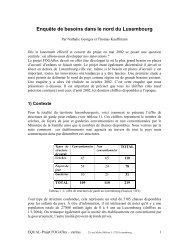Die Entwicklung integrierter familienunterstützender - Qualiflex.lu
Die Entwicklung integrierter familienunterstützender - Qualiflex.lu
Die Entwicklung integrierter familienunterstützender - Qualiflex.lu
You also want an ePaper? Increase the reach of your titles
YUMPU automatically turns print PDFs into web optimized ePapers that Google loves.
France - 2. Overview of programmes and concepts<br />
Childcare allowances and registered childminders<br />
‘Complément de libre choix du mode de garde’ (CLMG formerly termed<br />
AFEAMA) is an allowance provided to working parents who have at least<br />
one child aged under six cared for by a registered childminder. This childcare<br />
allowance covers the social security contributions to be paid by the<br />
employer (the family) of the registered childminder. An additional and income-related<br />
financial contribution is also given to the family. The number<br />
of families receiving this CLMG rose from 110,000 in 1991 to 685,000 in<br />
2005 (CNAF, 2007). As a result, the most common type of care arrangement<br />
for children under 3 years of age and having both parents working,<br />
except for care by one of the parents on parental leave, is now the registered<br />
child minder (around 30%).<br />
Another childcare allowance covers part of the social security contributions<br />
which must be paid by families who employ a person in their home (a<br />
‘nanny’) to care for their child(ren). In addition these families may deduct 50<br />
per cent of the real costs from their income tax 3 , up to a limit of 6,000 Euros<br />
per year.<br />
En 2005, there were around 375 000 registered childminders: 264 000 are<br />
directly employed by the parents. Child minders and home helpers are the<br />
occupations which have experienced the most rapid job growth since the<br />
1980s (+ 206% over the period 1982-2002, DARES, 2004).<br />
The structure of staffing for children in collective childcare provision<br />
Within the welfare system, in crèches and other centres, there are three types<br />
of workers. The puéricultrice usually works as the director of a centre. At least<br />
half of the staff in centres must be auxiliaires de puéricultrice. If the centre has<br />
more than 40 places, there must be at least one éducatrice de jeunes enfants; this<br />
group of workers are also increasingly applying to be directors of centres,<br />
creating a certain degree of tension with puéricultrices, who have traditionally<br />
had these senior posts.<br />
2.1.2 Integrated public child care services: the “Multi-accueil” child<br />
care facilities<br />
Over the last decade, there has been an increase in the number of these<br />
“Multi-accueil” services, sometimes also called “Maisons de la petite enfance”.<br />
They currently account for nearly three quarters of childcare facilities. For<br />
instance, from 2002 to 2006, the number of places of crèches located in<br />
these multi-accueil facilities increased from 33,400 to 51,029 (Bailleau, 2007).<br />
The rationale is to group together in one place, multiple and flexible<br />
childcare arrangements: crèches, halte-garderies (half-time), emergency care for<br />
children at risk, meeting rooms for childminders who look after children in<br />
3 If they pay income tax, taking into account that in France around half of the households don’t<br />
pay income tax as a result of the Quotient familial (Fagnani, Math, 2008).<br />
35



